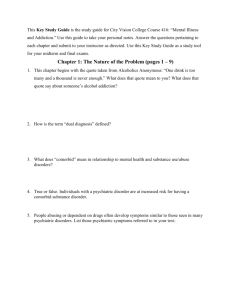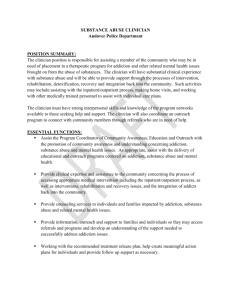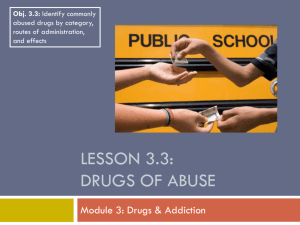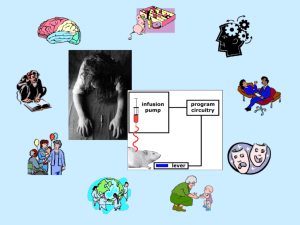VSIAS-SBIRT-2013 - Virginia Summer Institute for Addiction
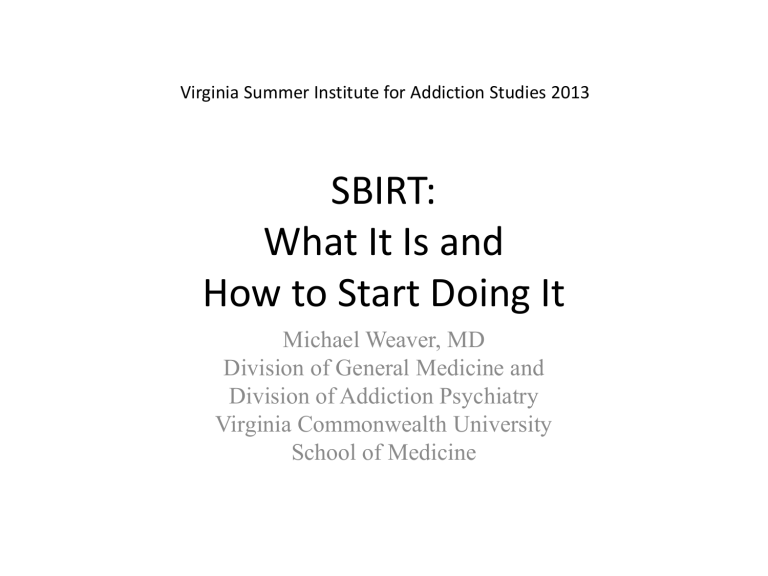
Virginia Summer Institute for Addiction Studies 2013
SBIRT:
What It Is and
How to Start Doing It
Michael Weaver, MD
Division of General Medicine and
Division of Addiction Psychiatry
Virginia Commonwealth University
School of Medicine
Objectives
• Classes of abused drugs
• Models of addiction
• Vulnerable populations
• Screening
• Brief intervention
• Addiction treatment
• Cases for Discussion
Drug Classes
• Sedativehypnotics
• Opioids
• Stimulants
• Hallucinogens
• Inhalants
• Marijuana
• Nicotine
Sedative-Hypnotics
• Alcohol, benzodiazepines, barbiturates
• CNS depressants
• Disinhibition: depress inhibitions first
– Reduce anxiety (fun at parties)
• Sedation, anxiolytic
• Oversedation, ataxia, respiratory depression
Other Sleeping Pills
• Bind to BZ receptor subtypes
– Zolpidem (Ambien)
– Zalaplon (Sonata)
– Eszopiclone (Lunesta)
• Behavioral pharmacological profile similar to benzodiazepines
– Drug liking, good effects, monetary street value
• Recommended for shortterm use, many taken longterm
• May cause hazardous confusion & falls
Opioids
• Morphine, heroin,
OxyContin, methadone
• Analgesics: disconnect from pain
• Euphoria, disconnection, sedation
• Nausea, constipation, itching
• Oversedation, respiratory depression
Prescription opioid misuse/abuse
• Use pain med to sleep, relax, soften negative affect
• Short-acting are the most easily & widely available
• Defeat extended-release mechanism
• Problems
– Sedation, confusion
– Respiratory depression
Stimulants
• Cocaine, amphetamine, methylphenidate, MDMA
(Ecstasy), caffeine
• Enhanced concentration, alertness
• Edginess, paranoia, hypervigilance, psychosis
• Hypertension, hyperthermia, vasoconstriction
– Heart attack, stroke
Prescription Stimulant Abuse
• Abused for euphoria, energy, alertness
• Abused by
– Students
– Long-distance drivers
– Polysubstance abusers
• Problems
– Vasoconstriction
– Agitation, psychosis
Caffeine
• Not just coffee, tea, soda
• Energy drinks
• Leads to
– Anxiety
– Tachycardia, palpitations
– Disrupted sleep
“Bath Salts”
• Synthetic derivatives of cathinone (khat)
– Designer drugs
– Methylenedioxypyrovalerone
– Methcathinone
– Methalone
• Potent stimulants and hallucinogens
• Labeled “not for human consumption”
– Smoke, snort
• Psychotic reactions
Hallucinogens
• LSD, mescaline, psilocybin
• Perceptual distortions
– Hallucinations
– Visual effects
• “Bad trip”
• Death most often due to perceptual and judgment errors
Volatile Inhalants
• Common & legal
• Use & abuse difficult to characterize
• Examples
– airplane glue (epoxies)
– Freon (“freebies”)
– carbon tetrachloride
– amyl & butyl nitrite
– nitrous oxide
– propellant (spraypaint)
Marijuana
• Pot, dope, Mary Jane
• Widely popular, easily available, not illegal in certain states
• Active ingredient: THC
• relaxation, hallucination
• short-term memory impairment, anterograde amnesia
• panic attacks
K2 and Spice
• Synthetic cannabinoids
– More potent than THC
• Solution sprayed on other plant material
– Sold as incense
– Smoked by users
• Serious reactions with intoxication
– Psychosis
Club Drugs
• “Ecstasy”
– Methylenedioxymethamphetamine
• Stimulant
• Hallucinogen
• Entactogen
• “Special K,” “kitty”
– Ketamine
• Hallucinogen
• Anesthetic
• Used by teens at dance clubs (“raves”)
• Relatively new drugs
• Erroneously presumed safe
• Many drugs may be substituted (not “as advertised”)
• Have arrived in Central
Virginia
Nicotine
• ~ 400,000 deaths each year from health consequences of tobacco
– Lung disease
– Heart disease
– Cancer
• Cigarettes, cigars, pipes
• Smokeless
– “snuff,” “chew,” snus
• Electronic cigarettes
Models of addiction
• Disease
• Genetic
• Self-medication
• Moral/volitional
Disease Model
• Biologic basis
• Chronic course
– Relapses and remissions
– No cure
– Like other chronic diseases
• Treatable
– Individualize therapy
– Medications may help improve outcomes
Picking your parents
• Liability for Substance
Use Disorders (SUD) aggregates in families
– Twin studies
– Adoption studies
– Genetic factors
• Genetic factors play an important role in alcohol and illicit drug use
“Your DNA test shows you’re predisposed to sue doctors.”
Self-medication
• Use of mood-altering substance is to ameliorate underlying negative psychiatric symptoms
– Stimulants for depression
– Alcohol or heroin for anxiety
Moral/Volitional Model
• Personal choice
• Weak willpower
• Moral failing
• Research doesn’t support this model
Vulnerable Populations
• Adolescents
• Elderly
• Psychiatric Co-Morbidity
Addiction is an equal opportunity disease
• Erroneous stereotypes
• All social strata
• All races
– different susceptibilities
• All age groups
• 10% of population have problems due to substance abuse
Epidemiology in Adolescents
• Youthful experimentation is common
– Experimental: use <6 times
– Most teens use drugs or alcohol occasionally without consequences
– 80% of high school students have used alcohol
• Problem behavior
– 55% of youth have tried an illegal drug by 12 th grade
– 35% of 12 th graders binge drink at least once a month
– 4% of adolescents drink daily
– 13% of adolescents smoke ½ pack/day
The Age Wave is cresting
• First ‘Baby Boomers’ just turned 65
• This generation used illicit drugs in youth
• Continue to use their drugs into older adulthood
• Different from previous generations
Sensitivity to alcohol with age
• Older adults more sensitive to alcohol
– Reduced total body water
• Higher concentrations
– Reduced metabolism in
GI tract
• Amount with little effect in youth causes intoxication in older adults
Psychiatric Co-Morbidity
• Higher risk for substance use among those with psychiatric disorders
– Depression or anxiety disorders
– Other psychiatric comorbidities
– Personality disorders
• May present with complex clinical histories and symptoms
– Diagnosis challenging
– Intoxication and withdrawal symptoms may be mistaken for other psychiatric or medical symptoms
• Cognitive-behavioral counseling more challenging
Dual Diagnosis
• Best success with treatment of both conditions simultaneously
• Contact with health care system is opportunity to intervene
– Earlier detection and intervention prevents problems
Clinicians often have difficulty identifying addicted patients
• Don’t think/don’t ask about it
• May not be obvious from a single visit
• Patients may be unable to admit the problem to themselves
• Patients may try to conceal it
Impact on
Healthcare Providers
• Medication misuse causes adverse health consequences for patient
• Worsens prognosis of coexisting medical and/or psychiatric conditions
• Significant proportion of practice is dealing with consequences of unrecognized/untreated addiction
• Leads to practitioner frustration
Why screen patients for addiction?
• Medical problems
– Cardiovascular disease
– Stroke
– Cancer
• Mental health
– Depression
– Anxiety
– Sleep problems
• Financial difficulties
• Legal problems
• Interpersonal problems
– Family issues
Screening makes a difference
• Patients reduce alcohol and tobacco use when this is addressed by a physician
• Research shows benefits from screening and brief intervention for illicit and prescription drug abuse
Screening Tool for
Alcohol Abuse
• CAGE Questions
– Cut down
– Annoyed
– Guilty
– Eye-opener
• Affirmative response to
2 or more is positive test
Diagnosis of
Alcohol Abuse/Dependence
• Continued substance use despite adverse consequences
• Use in larger amounts or for longer periods than intended
• Preoccupation with acquiring or using
• Inability to cut down, stop, or stay stopped, resulting in a relapse
• Use of multiple substances of abuse
APA 2000
Drinking Guidelines
• Men :
– 2 standard drinks/day
– No more than 14 drinks per week
– No more than 5 drinks on any one occasion
NIAAA 2005
• Women:
– 1 standard drink/day
– No more than 7 drinks per week
– No more than 5 drinks on any one occasion
Types of treatment
• Detoxification
• 12-Step groups
• Outpatient counseling
• Intensive outpatient
• Inpatient
• Residential
12-Step Groups
• A.A., N.A., C.A.
• Group format
• Anonymous
• No cost
• No affiliations or endorsement
• Different groups have different characteristics
Success with 12-Step
• More groups=more abstinence
• No threshold, but at least 2 meetings/week best
• Not affected by
– Gender
– Religion
– Psychiatric diagnosis
– Novice
Addiction Counseling
• Motivational
Interviewing
• Network therapy
• Family therapy
• Supportive psychotherapy
• Building Social
Networks
• Twelve-Step facilitation
• Perceptual Adjustment
Therapy
• Rational Recovery
• Medication
Management
• Brief Intervention
Treatment Matching
• Engage patients with addiction by matching to optimal setting and modalities for most effective and least restrictive level of care
• Base matching on
– Intoxication and withdrawal
– Medical complications, psychiatric factors
– Treatment acceptance/resistance
– Relapse potential, recovery environment
Treatment works
• Sustained remission rates of up to 60%
– Better success than treatment of hypertension, diabetes
• Every $1 spent on treatment saves $7 in costs to society
• Lots of new research
Patient Behavior
• Ambivalence
– Attracted to problem behavior (substance use)
• Denial
– Unable to admit problem to themselves
– Actively conceal
• Common to many chronic conditions
Motivation
• Probability of certain behaviors
• State of readiness to change
• May fluctuate from one situation to another
• Clinician’s goal is to increase the patient’s intrinsic motivation
– change arises from within rather than being imposed from without
Brief Intervention
• Motivate patients to change problem behavior
• Multiple brief sessions
• Bridge to treatment or sufficient itself
• Same impact as more extensive counseling
• Most cost effective
Weaver & Cotter 1998
Summary
• 10% of population has problems of addiction
• Different classes of drugs have different effects, from type of euphoria to side effects to withdrawal syndromes
• Addiction is a complex chronic disease with genetic and environmental factors
• Patients reduce substance abuse when this is addressed by a physician
• Recognition, diagnosis, and referral for treatment improves patient outcomes
• Screen for substance abuse in all patients, avoid stereotyping
• Addiction treatment is effective and cost-effective
• Brief intervention techniques help motivate patients to make healthier lifestyle changes
Questions?
Cases for Group Discussion
Objectives
• Stages of Change
• The 5 “A’s”
• Elements of Brief Intervention
• Practice Cases
Stages of Change
• Precontemplation
• Contemplation
• Preparation
• Action
• Maintenance
Precontemplation
• No intention to change behavior for the foreseeable future (at least in the next 6 months)
• Unaware that they have a problem
• Resistance to recognizing or modifying a problem
Contemplation
• Aware that a problem exists
– seriously thinking about overcoming problem
– not yet made a commitment to take action
• Seriously considering changing the behavior in the next 6 months
• Weighing of the pros and cons of the problem and the solution to the problem
• Facilitation
– Provide feedback (history, problems, labs, etc.)
Preparation
• Planning to change behavior
– intending to take action in the next month
– have unsuccessfully taken action in the past year
• May have made some reductions in problem behavior
• Not yet reached a criterion for effective action
– Not yet abstinent from illicit drugs
• Looking for advice
– Provide menu of choices
Action
• Modifying behavior, experiences, or environment to overcome problems
– considerable commitment of time and energy
– successfully altered behavior for 1 day to 6 months
• Facilitation
– Provide encouragement
– Assist to identify barriers and solutions
Maintenance
• Working to prevent relapse and consolidate gains attained during Action stage
• Extends from 6 months to an indeterminate period past the initial action, including a lifetime
• Hallmarks
– stabilizing behavior change
– avoiding relapse
Recycling
• Most people taking action to modify their behavior do not successfully maintain their gains on the first attempt
• Recycle through the Stages of Change several times before termination of the problem behavior
• During relapse, individuals regress to an earlier stage, but not usually all the way back to where they began
• Number of successes continues to increase gradually over time
The 5 “A’s”
• ASK about alcohol and drug use
• ADVISE all patients to quit
• ASSESS willingness to change
• ASSIST patients in quitting
• ARRANGE for follow-up
ASK about alcohol and drug use
• Have you ever used
– Tobacco products
– Caffeinated beverages
– Alcohol
– OTC drugs of abuse
– Prescription drugs of abuse
– Illicit drugs
• When did it begin?
• How often?
• How much?
• When was the last use?
ADVISE all patients to quit
• A strong recommendation to change substance use is essential
• "Based on the screening results, you are at high risk of having or developing a substance use disorder. It is medically in your best interest to
stop your use of [insert specific drugs here].”
• Recommend quitting before problems (or more problems) develop
– Give specific medical reasons
– Medically supervised detoxification may be necessary
ADVISE
• Many ways to change substance use behavior
– Community treatment programs, self-help groups, medications, etc.
• Treatment is often on an outpatient basis
• Programs are often accommodating of concerns
– Maintaining employment, insurance reimbursement, child care, etc.
• Whether to attend treatment will be the patient's decision
ASSESS willingness to change
• Have a conversation about whether the patient is ready to quit.
• You might say something like, "Given what we've talked about, do you want to
change your drug use?"
ASSESS
• If the patient is unwilling to quit, raise awareness about drugs as a health problem
• Revisit the issue at future visits
– Have resources available when he/she decides to pursue making a change
ASSIST patients in quitting
• Help set concrete (and reasonable) goals for making a change
• For patients not interested in a change plan, encourage them to set a few brief goals
– cutting back
– try a self-help group
ARRANGE for follow-up
• Refer high-risk patients for a full assessment
• If nearby treatment resources are not available, provide
– support group contact information
– self-change materials
– counseling resources
• Clergy
• Mental health referrals
ARRANGE
• For patients who attended referral and/or treatment
– Obtain records of assessment and/or treatment
– Discuss ways to help support recommendations
• For patients who did not attend the referral
– Offer additional brief intervention
– Make additional referrals
Elements of Brief Intervention
• FRAMES
– Feedback
– Responsibility
– Advice
– Menu
– Empathy
– Self-efficacy
Feedback
• Present information to client
– Based on history, exam, labs, etc.
• Increase awareness of adverse consequences
• Help make the case for change in drinking, med use, or illicit substances
Responsibility
• Client has the ultimate responsibility for change
• Practitioner can’t force client to change
• Client chooses goals, not practitioner
– Should be realistic
– Clarify client’s goals
– Develop discrepancy
Advice and Menu
• Give clear, concrete advice to change
• Give choices (menu)
– 3 is ideal
– Making a choice is first step to making a change in behavior
Empathy
• Listen carefully
• Clarify client’s meaning
• Don’t impose practitioner’s values on client
Self-efficacy
• Build up client’s belief in ability to succeed
• Be optimistic
• Simple goals early
– Success breeds success
– Increases selfconfidence
Motivating patients not yet ready to quit:
The 4 “R’s”
• RELEVANCE to that patient
• RISKS of continuing to use
• REWARDS of quitting
• REPETITION at each encounter
Questions?
Practice Cases
• Interviewing style
– Non-judgmental attitude
– Open-ended questions
– Identify stage of change
• Brief Intervention format
– Use of some of the FRAMES elements
– Use of some of the 5 A’s
Practice Cases
• Roles to play
– Clinician
– Patient
– Observers (2)
• Groups of 4 people
• Decide role for each person
– Read page for your role
• “Clinician” and “Patient” do role play
• Observers give constructive feedback afterward
Practice Cases
• Stage of change of patient
• What FRAMES elements were used?
• Which of the 5 A’s were used?
• What felt awkward?
– Clinician
– Patient
• What seemed more natural?
– Clinician
– Patient
